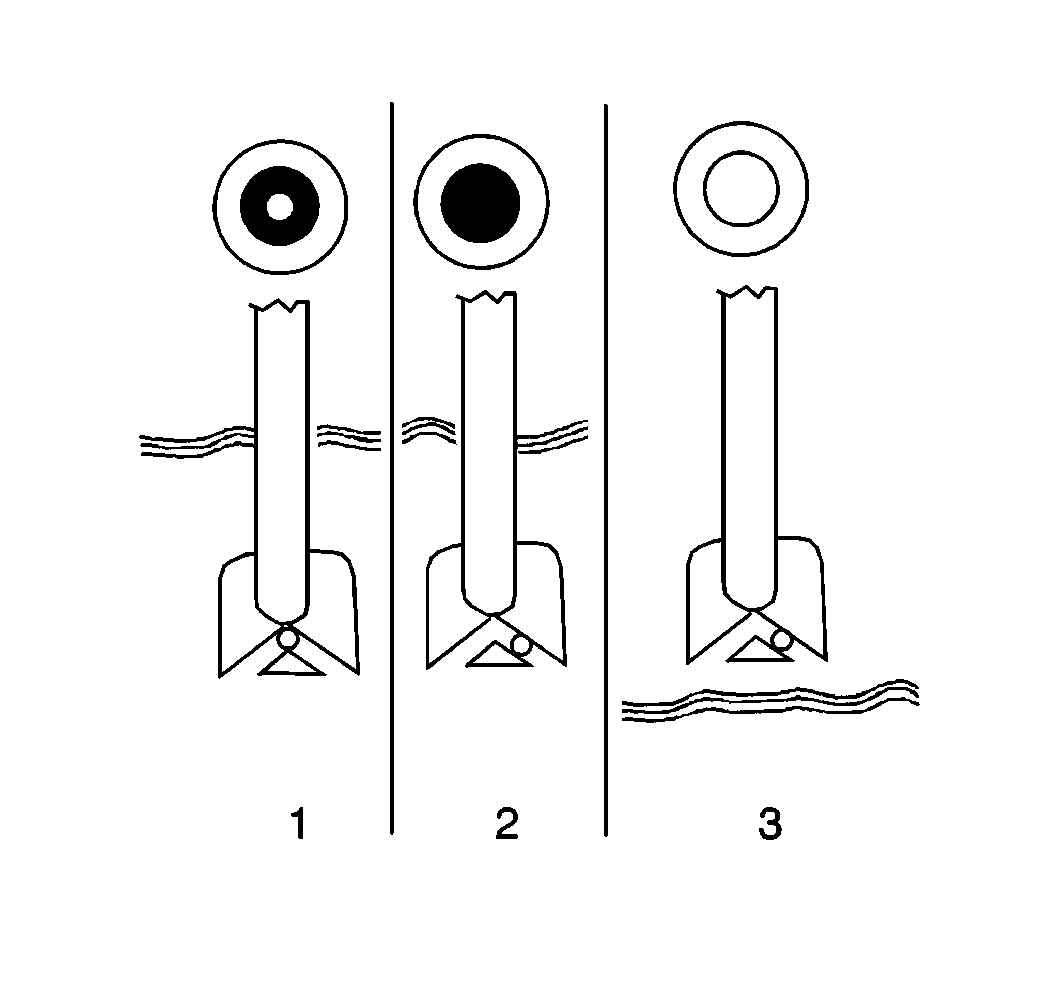Basic Rules
When charging the battery, follow these basic rules:
| • | Use a charger with an end of charge voltage of 16.0 volts.
The charger should have a voltmeter that is accurate within 1 percent. |
| • | Ambient temperature should be 15-38°C (60-100°F).
An extremely cold battery may not accept measurable current after several
hours of charging. |
| • | The charging area should be well ventilated. |
| • |

Do not charge the battery
if the built-in hydrometer is clear or light yellow (3). If cranking problems
exist, replace the battery. |
| • | Do not charge a battery that seems to be frozen. Replace the frozen
battery. |
| • | A battery with a green dot showing in the hydrometer (1) does
not require charging unless the battery has been discharged, such as from
cranking. |
Charging Procedure

Notice: Always turn the ignition OFF when connecting or disconnecting
battery cables, battery chargers, or jumper cables. Failing to do so may damage
the Powertrain Control Module (PCM) or other electronic components.
Important: Tighten the adapters against the lead terminals of the battery in order
to keep the resistance between the adapters and the battery terminals to a
minimum.
- Make sure all connections to the charger are clean and tight. When charging
side terminal batteries out of the vehicle, install a pair of GM P/N 12303040
.

Important: Do not use the charger settings for jump-starting vehicles in order
to charge the battery.
- Set the charger for 12-volt batteries that gives the highest charge
rate. Charge the battery until the green dot (1) appears.
| • | Check the battery periodically while charging. |
| • | Lightly tap the hydrometer on top in order to dislodge any air
bubbles that may prevent a correct indication. |
- Discontinue charging, or reduce the charging rate, if the following
apply:
| • | The battery feels hot, above 52°C (125°F) |
| • | Violent gassing or spewing of electrolyte through the vent holes |
- After charging, test the battery. Refer to
Battery Not Operating Properly
and
Battery Electrical Drain/Parasitic Load
.
Charging Time Required
The time required to charge a battery will vary. The time depends on
the following factors:
| • | Size of the battery -- A completely discharged heavy-duty
battery requires more than twice the recharging time as a completely discharged
light-duty battery. |
| • | Temperature -- Colder batteries require more time to recharge.
Cold batteries accept only very low current at first during charging. The
cold battery will accept a higher charging rate as the battery warms. |
| • | Charger Capacity -- A charger with higher amperage charges
batteries in less time. |
| • | State-Of-Charge -- A completely discharged battery requires
more than twice as much charge as a one-half charged battery. The electrolyte
in a completely discharged battery is nearly pure water, so the electrolyte
is a very poor conductor. In this condition, the battery accepts very low
current at first. Later, as the charging current increases the acid content
of the electrolyte, the charging current also increases. |
Any battery discharged by parasitic current drain, and then allowed
to stand in this condition for a period of time, may not readily accept a
charge. However, recharged long enough, many batteries will return to a usable
condition.
Prolonged periods in a discharged state can result in permanent damage
to the battery. This damage can accelerate under changing temperatures. Batteries
that are extremely discharged can freeze at temperatures as high as -7°C
(20°F). This results in permanent damage.
Disconnect the negative battery cable of vehicles that are not going
to be in service within a 30-day period. This will remove the constant
drain on the battery. This can prevent damage to the battery and recharge
problems. If this is not possible, recharge the battery every 30-45
days until the green dot is visible.



